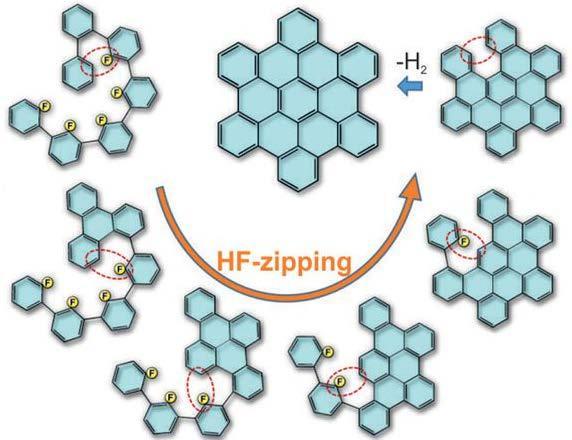Nanographenes on titanium dioxide. Physicists of the Department of Physics of Nanostructures and Nanotechnology for the first time synthesized nanographenes directly on the surface of titanium dioxide.
Controlled, atomically precise synthesis of nanostructures is one of the main challenges in building nanoscale devices, especially regarding the needs of future electronics. One of the approaches is based on producing such systems directly on the surface of the substrate. This new field called “on-surface synthesis” has recently shown very high efficiency in obtaining atomically precise molecular systems such as nanoribbons and nanographenes as well as in producing molecules synthesis of which was unreachable for decades. However in most cases this reaction requires the use of catalytic substrates which reduces the possibility of synthesis to metal surfaces, making it impossible to use key semiconducting and insulating surfaces.
Physicists of the Department of Physics of Nanostructures and Nanotechnology for the first time synthesized nanographenes directly on the surface of titanium dioxide using specific precursor molecules designed by collaborators of Friedrich-Alexander University Erlangen-Nuremberg. It was made possible by equipping molecules with fluorine atoms located in precisely defined positions. As a result of sequential and completely selective activation of carbon-fluorine bonds the closure of subsequent aromatic rings may take place omitting the reaction of cyclodehydrogenation. It paves the way toward fabrication of new molecular systems with atomic precision on nonmetallic surfaces. It helps to avoid complicated process of transfer of molecular nanostructures from metal surfaces, on which they can be synthesized due to catalytic qualities of the substrate, to important technologically semiconducting surfaces. Obtained results are an important step in developing synthesis of atomically precise molecular structures performed directly on crystalline surfaces.

You can read more about the results of the research in the first this year issue of „Science” magazine (http://science.sciencemag.org/content/363/6422/57?rss=1): Fluorine-programmed nanozipping to tailored nanographenes on rutile TiO2 surfaces, M. Kolmer, R. Zuzak, A. K. Steiner, Ł. Zając, M. Engelund, S. Godlewski, M. Szymoński, K. Amsharov, Science 2019, 363, 57-60.

